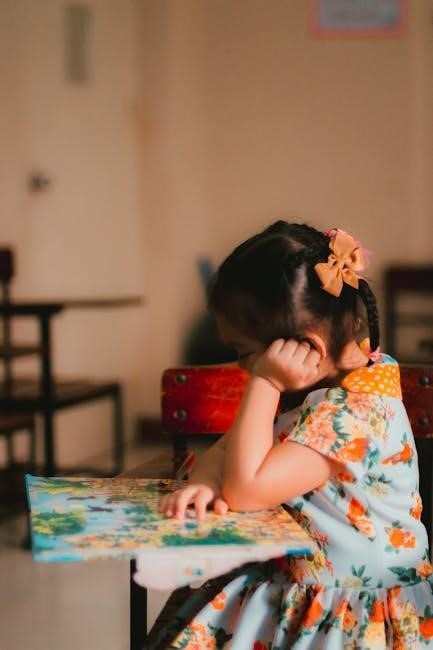The Hundred Dresses: An Overview
Eleanor Estes’ “The Hundred Dresses” tells the story of Wanda Petronski‚ a Polish girl facing prejudice in America. The book‚ often found in PDF format online‚ explores themes of bullying and empathy. It highlights the importance of kindness. It is also a Newbery Honor classic.
Main Characters and Their Roles
The main characters include Wanda Petronski‚ the teased girl; Peggy‚ the popular and sometimes unkind classmate; and Maddie‚ Peggy’s best friend who grapples with her conscience. These characters drive the narrative and its exploration of social dynamics. Their roles are central to understanding the book’s message.
Wanda Petronski
Wanda Petronski‚ a central figure in “The Hundred Dresses‚” is a Polish immigrant girl attending an American school in the 1930s. She lives in Boggins Heights and is marked as an outsider. She is set apart from her classmates due to her family’s poverty and her unfashionable‚ faded blue dress that she wears daily.
Despite her circumstances‚ Wanda possesses a quiet dignity and a creative spirit‚ which she expresses through her artistic talent. The story revolves around her claim of having a hundred dresses at home‚ which becomes the subject of ridicule and teasing by her classmates‚ particularly Peggy and Maddie.
Wanda’s character serves as a symbol of resilience and the impact of prejudice on individuals. Her eventual withdrawal from school highlights the painful consequences of bullying and the importance of empathy and understanding. Even in the face of adversity‚ Wanda’s talent shines through‚ leaving a lasting impression on those around her.
Maddie
Maddie‚ in “The Hundred Dresses‚” is a complex character grappling with her conscience. She is Peggy’s best friend and often finds herself complicit in the teasing directed towards Wanda Petronski. Maddie is not inherently cruel‚ but her fear of losing Peggy’s friendship keeps her from speaking out against the bullying. Maddie herself comes from a poor background. She often wears hand-me-down clothes‚ making her sympathetic to Wanda’s situation.
As the story progresses‚ Maddie’s guilt intensifies. She starts realizing the harm caused by her silence. This realization becomes a turning point for her‚ prompting her to question her own behavior and the dynamics of her friendship with Peggy. She understands that allowing her friend to be a bully can be just as bad as acting that way herself.
Maddie’s internal struggle represents the moral dilemma of bystanders. She highlights the importance of standing up for what is right. Her character arc emphasizes the potential for growth and the courage required to overcome personal fears in the face of injustice.
Peggy
Peggy‚ a central figure in “The Hundred Dresses‚” is portrayed as the most popular girl in school‚ possessing beauty‚ pretty clothes‚ and curly auburn hair. However‚ she is also the primary instigator of the teasing directed at Wanda Petronski. Peggy rationalizes her behavior by convincing herself that she is merely having fun and that Wanda’s claims of owning a hundred dresses are inherently untruthful. She doesn’t consider herself a bully‚ but rather someone who is simply joking.
Despite her popularity and seemingly confident demeanor‚ Peggy’s actions reveal a deeper insecurity. Her need to tease Wanda may stem from a desire to maintain her social status and feel superior. While she considers Maddie her closest friend‚ she is largely unaware of the discomfort her actions cause Maddie. Peggy’s character serves as a representation of thoughtlessness and the potential for harm‚ even when intentions are not malicious.
Peggy’s initial lack of empathy highlights the need for self-reflection and awareness of the impact of one’s words and actions on others. She is a complex character whose transformation‚ though subtle‚ underscores the story’s message of kindness and understanding.

Plot Summary and Key Events
“The Hundred Dresses” revolves around Wanda Petronski‚ a Polish immigrant girl in an American school‚ who is constantly teased by her classmates‚ particularly Peggy‚ for claiming to have a hundred dresses despite always wearing the same faded blue one. The teasing escalates daily as Peggy and others relentlessly question Wanda about her supposed wardrobe.
Maddie‚ Peggy’s best friend‚ feels increasingly uncomfortable with the situation‚ as she herself comes from a poor family and understands what it feels like to be different. She longs to tell Peggy to stop‚ but fears losing her friend’s approval and becoming a target herself. The story reaches a turning point when Wanda and her brother abruptly leave town due to the prejudice they face.
Before leaving‚ Wanda submits her drawings to a school contest‚ revealing a hundred beautifully designed dresses‚ each unique and vibrant. This act exposes the girls’ cruelty and forces Peggy and Maddie to confront the consequences of their actions. The plot emphasizes themes of empathy‚ regret‚ and the importance of standing up against injustice.
Themes of Prejudice and Bullying
“The Hundred Dresses” poignantly addresses the pervasive themes of prejudice and bullying through the experiences of Wanda Petronski. Wanda‚ a Polish immigrant‚ becomes the target of relentless teasing and ridicule due to her different background‚ her unusual name‚ and her family’s poverty. Her classmates‚ particularly Peggy‚ mock her claims of having a hundred dresses‚ highlighting the insensitivity and cruelty that arise from prejudice.
The story exposes how prejudice manifests in everyday interactions‚ creating a hostile environment for those who are perceived as “different.” It also delves into the dynamics of bullying‚ illustrating how a popular individual like Peggy can influence others to participate in harmful behavior. Maddie’s internal conflict further emphasizes the complexities of the issue‚ as she struggles with her conscience but fears becoming a target herself.
Through Wanda’s experiences‚ the book underscores the devastating impact of prejudice and bullying on individuals‚ communities‚ and highlights the importance of empathy.
Empathy and Understanding
“The Hundred Dresses” profoundly emphasizes the significance of empathy and understanding‚ urging readers to step into the shoes of others and recognize their inherent worth. Through Maddie’s transformation‚ the story illustrates the power of empathy to overcome prejudice and promote kindness. Maddie’s initial reluctance to stand up for Wanda stems from her fear of becoming a target herself‚ but as she witnesses the pain inflicted on Wanda‚ she experiences a growing sense of guilt and remorse.
This realization prompts Maddie to develop a deeper understanding of Wanda’s situation‚ recognizing that her actions‚ even through silence‚ contributed to the bullying. Her newfound empathy motivates her to take a stand against injustice and to actively seek ways to make amends for her past behavior.
The book ultimately conveys that empathy and understanding are essential for building a more compassionate and inclusive society‚ where every individual is valued and respected.

The Significance of the “Hundred Dresses”
The titular “hundred dresses” in Eleanor Estes’ story holds profound symbolic weight‚ representing Wanda Petronski’s resilience‚ creativity‚ and the power of imagination to transcend difficult circumstances. Initially‚ Wanda’s claim of owning a hundred dresses is met with disbelief and mockery from her classmates‚ who fail to recognize the depth of her artistic talent and the richness of her inner world. However‚ as the story unfolds‚ it becomes clear that Wanda’s dresses are not mere fabric‚ but rather expressions of her dreams‚ aspirations‚ and unique perspective on the world.
Through her art‚ Wanda transforms her perceived limitations into a source of strength and beauty‚ demonstrating that true wealth lies not in material possessions‚ but in the ability to create and inspire. The dresses come to represent Wanda’s hidden value and the importance of looking beyond superficial appearances to appreciate the individuality of others.

Author Eleanor Estes and the Book’s Context
Eleanor Estes‚ the acclaimed author of “The Hundred Dresses‚” penned this poignant children’s classic in 1941‚ drawing upon her own experiences and observations of social dynamics during that era. Born in 1906‚ Estes grew up in a small town‚ which provided the backdrop for many of her stories. “The Hundred Dresses” reflects the societal prejudices and cultural insensitivities prevalent in 1930s America‚ particularly towards immigrants and those perceived as different.
Estes’ writing often explored themes of childhood‚ family‚ and the challenges of growing up‚ and “The Hundred Dresses” is no exception. Through the character of Wanda Petronski‚ Estes sheds light on the impact of bullying and the importance of empathy and understanding. The book’s context is crucial to understanding its message‚ as it highlights the historical realities of prejudice and discrimination‚ urging readers to reflect on their own biases and actions.
Educational Value and Relevance Today
“The Hundred Dresses” retains significant educational value and relevance in contemporary society. Its exploration of themes such as bullying‚ prejudice‚ empathy‚ and social responsibility makes it a valuable tool for educators and parents alike. The story encourages critical thinking about the consequences of our actions and the importance of treating others with respect and kindness‚ regardless of their background or circumstances.
The book serves as a powerful catalyst for discussions about diversity‚ inclusion‚ and the impact of discrimination on individuals and communities. By examining the experiences of Wanda Petronski‚ students can develop a deeper understanding of the importance of standing up against injustice and promoting a more equitable and compassionate world. “The Hundred Dresses” remains a timeless resource for fostering empathy and promoting positive social change in classrooms and beyond. It is also a Newberry Honor classic.

Availability of “The Hundred Dresses” PDF
Accessing “The Hundred Dresses” in PDF format is quite convenient due to its widespread availability across various online platforms. Numerous websites offer the book as a free PDF download‚ allowing readers to easily access the story on their computers‚ tablets‚ or smartphones. These platforms often include online libraries‚ educational resource websites‚ and file-sharing services.
However‚ it is essential to exercise caution and ensure that the PDF is downloaded from a reputable source to avoid potential malware or copyright infringement issues. Many legitimate sources‚ such as school websites or online bookstores‚ may also offer the PDF for purchase or rental. Always check the copyright and terms of use before downloading the PDF. A simple search will lead to many options‚ including free and paid versions. This classic is widely available.
